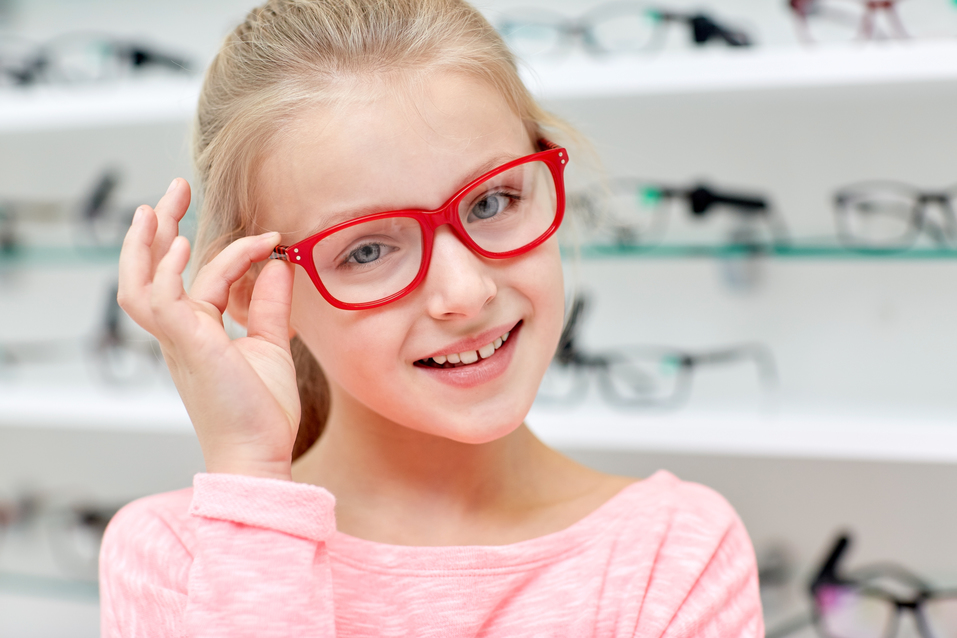In the first part of this series “Blue Light: Should I worry about it? Part 1”, we introduced blue light. It’s naturally present in sunlight, and has shorter wavelengths and more energy than the brighter colors.However, this light is not only found in sunlight.
Modern digital devices and white LEDs are also sources of blue light. Sources, such as computer monitors, flat screen LED televisions and smartphones contain a relatively small amount of blue light. Unfortunately, in today’s society it is normal to be exposed to such sources for prolonged periods of time – think: checking your emails, writing reports, or even your children playing games on a tablet. This is where problems arise. Our pediatric eye doctor understands that prolonged exposure at close proximity can lead to serious eye and vision damage, especially to children whose eyes and vision are more sensitive. With a staggering 70% of American children receiving more than 2 hours of screen time daily, this issue is hugely under-publicised.

You are probably thinking of ways to protect your loved ones from the damage. Let us help you out! Today, we will explain what damage excessive exposure to blue light can cause, and how you can prevent it.
Effects of Blue Light
Excessive exposure to blue light is proven to have the potential to lead to three conditions: digital eye strain, retina damage and eye dryness. Also, since naturally occurring blue light has the job of controlling our body’s circadian rhythm, exposure to digital devices during the evening, or night can affect your ability to fall asleep.
Digital Eye Strain
This condition is an umbrella term for a collection of symptoms related to screen use. Research shows that after being exposed to digital screens for longer than 2 hours at a time Americans commonly experience eye strain, dry eyes, headaches, blurred vision and neck and shoulder pain. Those are only the physical symptoms. The same exposure to digital screens resulted in 15.2% of children showing a reduced attention span, 13.3% exercising poor behavior and 13.5% becoming more irritable.
Digital eye strain is also amplified by bad lightning and the proximity to the screen, as blue light from digital devices decreases the light contrast.
Additionally, eye dryness is a result of children and adults not blinking as much whilst using screens.
Retina damage
As we have explained in the first part of this article, excessive blue light exposure is linked to progressive destruction of light-detecting cells in the eyes. Hence, it contributes to age-related molecular degeneration (AMD), which is a leading cause of blindness. AMD is commonly experienced by older people with 2 million Americans age 50 and older suffering from advanced AMD.
However, age is only one of many risk factors for the disease. Other risk factors include:
- Genetics
- Race (Caucasian)
- Cigarette smoking
- Cumulative exposure to UV and/or HEV light over the course of your lifetime.
- HEV – High-energy visible light in the violet/blue range from 400 to 450nm.
This is why our children’s eye doctor emphasizes the importance of raising awareness about the negative effects excessive screen exposure has, especially on our little ones.
Protecting your Eyes from Blue Light
The doctors at the American Academy of Ophthalmology claim that the best way to protect your eyes from digital eye strain is to limit exposure. They suggest following the “20-20-20” rule: “Every 20 minutes, shift your eyes to look at an object at least 20 feet away for at least 20 seconds”.
If the above habit is difficult for your children to follow, try sticking a specialized screen filter onto their smartphones, tablets, or computer screens. The children won’t notice the change and the amount of blue light reaching their eyes will be decreased. A win-win!
What you can also try is eyewear specialized to filter blue-light and reduce glare. To find out more about your options speak to our children’s eye doctor. These lenses can be incorporated into almost any pair of frames, so your children don’t have to sacrifice their style, or your bank account balance.
About our Pediatric Eye Doctor in Livingston!
Our exceptional doctors, Amy Lambert, MD, and Rachel Bloom, MD, are both board certified pediatric ophthalmologists. Dr. Lambert, the founder of Pediatric Eye Associates, LLc, is also a board certified strabismus surgeon, and Dr. Bloom is additionally fellowship trained.
Our pediatric eye doctors are experts at meeting your children’s eye and visual needs. We pride ourselves with the results we achieve with our patients and we believe the key is not just our medical expertise, but also attitude and patience with the children. Our motto is “to provide the highest quality eye care for children in a setting that is comfortable and reassuring.”
We understand that you will have many questions about our Livingston ophthalmologist, so if any of them are still unanswered, please refer to our FAQs page, or contact us. You can get in touch with us by:
- Visiting our practice
22 Old Short Hills Rd. Lower Level-1,Livingston, New Jersey 07039
Open hours: Monday – Friday 9:00 – 17:00
- Calling us on 973-422-1230
- Submitting the enquiry form on our contact us page
- Checking our facebook page – Pediatric Eye Associates, LLC
The material contained on this site is for informational purposes only and DOES NOT CONSTITUTE THE PROVIDING OF MEDICAL ADVICE, and is not intended to be a substitute for independent professional medical judgment, advice, diagnosis, or treatment. Always seek the advice of your physician or other qualified healthcare provider with any questions or concerns you may have regarding your health.
